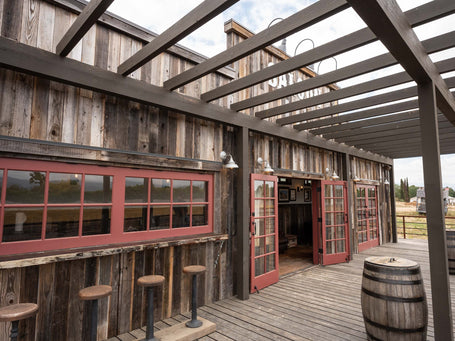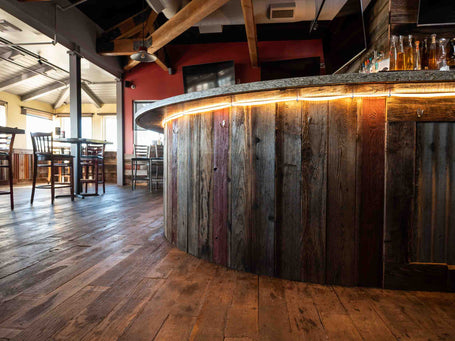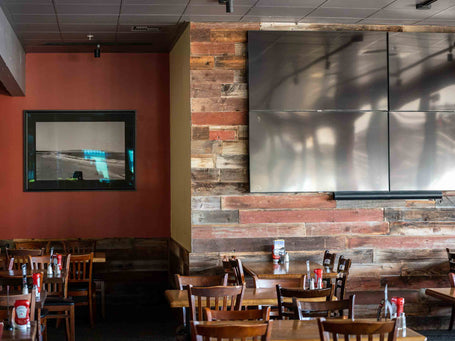Introduction
In the quest for sustainable living, reclaimed wood has emerged as an eco-friendly choice that not only adds beauty and character to homes but also supports environmental conservation. At Huasna, we are committed to promoting sustainability through the use of reclaimed wood, which helps reduce deforestation, lower carbon footprints, and preserve historical resources. This article explores how choosing reclaimed wood for your walls can significantly boost sustainability in the United States.
Environmental Benefits of Reclaimed Wood
Reducing Deforestation
Deforestation is a major environmental concern, leading to habitat loss, decreased biodiversity, and increased carbon emissions. By opting for reclaimed wood, we can reduce the demand for new lumber, thus helping to conserve forests. According to the World Wildlife Fund, the use of reclaimed wood can save an estimated 20 to 40 acres of forestland annually. This contributes to the preservation of critical ecosystems and the protection of wildlife habitats.
Lowering Carbon Footprint
The production of new lumber involves cutting down trees, processing the wood, and transporting it to various locations—all activities that contribute to greenhouse gas emissions. Reclaimed wood, however, has already undergone these processes. By repurposing existing wood, we significantly lower the carbon footprint associated with new wood production. A study by the U.S. Environmental Protection Agency (EPA) found that using reclaimed wood can reduce carbon emissions by up to 75% compared to new lumber.
Waste Reduction
The construction and demolition industry generates millions of tons of waste each year, much of which ends up in landfills. Reclaimed wood helps mitigate this problem by diverting wood waste from landfills and giving it a new purpose. This not only reduces the environmental burden of waste disposal but also promotes a circular economy where materials are reused and repurposed rather than discarded.
Social and Economic Benefits
Supporting Local Economies
The reclaimed wood industry often relies on local sources and small businesses for the collection, processing, and distribution of materials. This supports local economies by providing jobs and promoting economic growth within communities. Additionally, purchasing reclaimed wood from local suppliers reduces transportation costs and emissions, further enhancing its sustainability.
Preserving Historical Resources
Reclaimed wood often comes from old barns, factories, and other historical structures that have been part of America's cultural heritage for generations. By repurposing this wood, we preserve a piece of history and honor the craftsmanship of the past. This connection to history adds cultural value to reclaimed wood products and enriches our understanding of architectural heritage.
The Aesthetic and Practical Benefits of Reclaimed Wood Walls
Unique Character and Beauty
Each piece of reclaimed wood has its own unique story, reflected in its weathered texture, patina, and historical marks. This uniqueness adds a rustic charm and authenticity to any wall, making reclaimed wood a sought-after material for interior design. Whether you’re creating an accent wall or a full room makeover, reclaimed wood brings a distinctive aesthetic that new wood simply cannot replicate.
Durability and Stability
Reclaimed wood is often more durable and stable than new wood because it has been seasoned and weathered over time. This makes it less prone to warping, shrinking, or cracking, ensuring that your reclaimed wood wall will stand the test of time. Its inherent strength and resilience make it an excellent choice for high-traffic areas and long-lasting installations.
How to Choose and Install Reclaimed Wood for Walls
Selecting Quality Reclaimed Wood
When choosing reclaimed wood, it’s essential to consider the quality and source of the materials. At Huasna, we ensure that our reclaimed wood planks are carefully selected from authentic structures, preserving their unique character and integrity. Look for wood that is free from rot, pests, and excessive damage to ensure a high-quality installation.
Preparing the Wall
Before installing reclaimed wood, prepare the wall by cleaning it thoroughly and ensuring it is dry and flat. If necessary, install furring strips or plywood backing to create a stable surface for attaching the wood planks.
Installation Tips
- Plan the Layout: Before beginning, plan the layout of the wood planks to achieve the desired pattern and aesthetic. Consider staggering the joints for a more natural look.
- Use Adhesive and Fasteners: Apply construction adhesive to the back of each plank and secure it to the wall using finishing nails or screws. Ensure each plank is level and fits snugly against the adjacent pieces.
- Seal and Finish: After installation, apply a sealant or finish to protect the wood and enhance its appearance. This step is optional but recommended for areas exposed to moisture or heavy use.
Why Choose Huasna?
At Huasna, we are dedicated to providing high-quality reclaimed wood that supports sustainability and enhances your home’s aesthetic appeal. Our barn wood planks are sourced from authentic structures, ensuring each piece carries its own unique history and character. We prioritize sustainability and quality, offering materials that are both environmentally friendly and built to last.
Whether you’re a DIY enthusiast, a professional designer, or simply someone who values sustainable living, Huasna is here to help you make eco-friendly choices that benefit the planet and enrich your home. Explore our collection of reclaimed wood and discover how it can transform your space into a haven of warmth, history, and sustainability.






